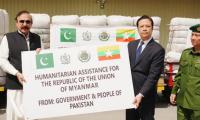ISLAMABAD: Pakistan’s economy is showing signs of steady recovery in the early months of fiscal year 2025, driven by improvements across key sectors, declining inflation, and enhanced fiscal discipline.
Large-scale manufacturing is rebounding after a period of decline, with key export sectors preparing to ramp up production. The recovery is expected to benefit from a favorable external environment, stable exchange rates, and easing inflationary pressures. An accommodative monetary policy, improved investor confidence, and a recovering global market are also anticipated to sustain industrial growth. The government’s focus on fiscal consolidation is expected to improve the country’s fiscal accounts, according to the latest Economic Update and Outlook from the Finance Division.
In agriculture, Rabi 2024 production will largely depend on weather conditions, which are expected to play a crucial role in determining overall productivity. Rabi season, from October 1 to March 31, sees the cultivation of Wheat, Gram, Lentil, Potatoes, Onions, and Tomatoes.
Inflation is projected to stay between 8 to 9 per cent through September and October 2024.
On the external front, both exports and imports are expected to gain momentum. In September 2024, exports are forecast to range between $2.5 billion and $3 billion, while imports are expected to fall between $4.5 billion and $5 billion. Workers’ remittances are projected to be between $2.7 billion and $3.2 billion.
Already inflation has dropped to single digit for the first time in nearly three years. In August 2024, the Consumer Price Index (CPI) recorded a year-on-year increase of 9.6 per cent, compared to 27.4 per cent in August 2023. The deceleration in inflation is attributed to a reduction in food prices and energy costs, among other factors. On a monthly basis, inflation rose by just 0.4 per cent, signaling a further reduction in inflationary pressures for the coming months.
Large-scale manufacturing (LSM), a critical component of Pakistan’s industrial sector, recorded a 2.4 per cent increase in output in July 2024 after a long period of contraction, driven by positive growth in key sectors like textiles, food, chemicals, and automobiles. Notably, textile manufacturing, which has the highest weight in LSM, ended its 24-month decline.
Vehicle production and sales witnessed robust growth, with car production rising by 15 per cent and truck and bus production jumping by 120.4 per cent during July-August FY2025. However, some sectors like cement showed a decline, with dispatches dropping by 17.8 per cent compared to the same period last year.
Pakistan’s external account strengthened due to higher exports and remittances, though imports also rose. During Jul-Aug FY2025, the current account posted a $0.2 billion deficit, compared to $0.9 billion last year. In August 2024, it recorded a $75 million surplus.
Goods exports increased 7.2 per cent to $4.9 billion, while imports reached $9.5 billion, leading to a $4.7 billion trade deficit. Key export growth areas included rice (98.6pc), fruits & vegetables (26.7pc), knitwear (7.2pc), and readymade garments (17.9pc). Imports surged in petroleum crude (107pc) and fertilizer (622pc).
Service exports grew 0.2 per cent to $1.2 billion, while imports fell 0.5pc to $1.7 billion, resulting in a $0.47 billion deficit.
IT exports rose 30.2 per cent to $0.6 billion. Foreign Direct Investment (FDI) increased 55.5 per cent to $350 million, led by China ($175 million), Hong Kong ($70 million) and UK ($43.5 million), with the power sector attracting $210 million.
Workers’ remittances surged 44 per cent to $5.9 billion, driven by inflows from Saudi Arabia (25pc). Total foreign exchange reserves stood at $14.9 billion, with the State Bank holding $9.5 billion.
The fiscal sector also showed resilience, with net federal revenues growing by 7.2 per cent year-on-year in July FY2025 to Rs408.4 billion. This growth was driven by a 22.6 per cent increase in tax collection and a 20.5 per cent rise in non-tax revenues, particularly from the petroleum levy, which surged to Rs83.6 billion.
Total expenditures rose by 19.2 per cent to Rs768.6 billion, leading to a fiscal deficit of 0.3 per cent of GDP, compared to 0.2 per cent last year. The primary balance posted a surplus of 0.1 per cent of GDP, down from 0.3 per cent last year.
During Jul-Aug FY2025, FBR’s net tax collection increased by 20.6 per cent to Rs1.456 trillion, compared to Rs1.207 trillion during the same period last year. In August 2024, tax collection rose 19 per cent to Rs796 billion, up from Rs669 billion the previous year.
The Pakistan Stock Market continues its upward trend, buoyed by easing inflationary pressures, improved inflation expectations, and increased business confidence. On September 12, 2024, the Monetary Policy Committee (MPC) reduced the policy rate by 200 basis points to 17.5 per cent.
From July 1 to August 30, FY2025, money supply (M2) contracted by 2.6 per cent (Rs962.3 billion), compared to a 1.4 per cent decline (Rs449.5 billion) last year. In August 2024, the KSE-100 index hovered around 78,000 points and closed at 78,488, gaining 601 points. Market capitalization increased by Rs117 billion, settling at Rs10,485 billion.
Meanwhile, according to government data released Friday, the weekly inflation rate reached 12.8 per cent year-on-year for the week ending September 26. This marks the lowest level in three years.
The weekly inflation measured by the Sensitive Price Indicator (SPI), tracks the cost of essential items like food and household necessities, showed a 0.05 per cent increase from the previous week, the Pakistan Bureau of Statistics (PBS) said.
Year-on-year, the 12.8 per cent SPI is the lowest level since October 2021, after weekly inflation peaked at 48.35 per cent in May 2023. Notably, the weekly inflation has been in double-digit since February 2020.
Of the 51 items monitored across 50 markets in 17 cities, the prices of 16 items rose, 9 decreased, and 26 remained unchanged compared with the previous week.
Tomatoes prices increased by 5.78 per cent, onions by 5.49 per cent, pulse gram 1.01 per cent, fresh milk by 0.26 per cent, and liquefied petroleum gas (LPG) by 0.15 per cent over the previous week.
Whereas, mash pulse price reduced by 1.8 per cent, moong pulse by 1.35 pe cent, sugar by 1.3 per cent, bananas by 1.27 per cent, masoor pulse by 1 per cent, wheat flour by 0.66 per cent, eggs by 0.28 per cent and cooking oil by 0.18 per cent over previous week.
For households earning less than Rs17,732 per month, inflation increased 0.08 per cent for the week, while the highest income group, earning more than Rs44,175 monthly, saw a drop of 0.04 per cent. On a yearly basis, the SPI rose 9.2 per cent for the lowest income group and 11.09 per cent for the highest income group.
While year-on-year, gas prices hiked by 570 per cent for the lowest consumer slab, followed by a 60 per cent spike in gram pulse prices. Similarly, onions prices increased by 52 per cent, tomatoes
34 per cent, beef 26 per cent, powdered milk 25 per cent, shirting 20 per cent, chicken 17 per cent, cooked daal 16 per cent, salt powder 15 per cent, georgette 14 per cent and energy saver price down by 13 per cent over a year ago.
Conversely, on a year-on-year basis, wheat flour was cheaper by 38 per cent, petrol 25 per cent, diesel 24 per cent, chilies powder 20 per cent, electricity charges for the lowest slab by 13.5 per cent, sugar 11 per cent, cooking oil 11 per cent, and rice basmati (broken) 10 per cent. Besides, masoor pulse price reduced by 9.2 per cent, vegetable ghee and gur by six per cent each and LPG by two per cent over the same period last year.
Opposition parties strongly criticised move, accusing BJP government of targeting Muslim community ahead of Eid
“Efforts of KP government, led by CM Ali Amin Gnadapur are yielding positive results,” he said in a statement
Despite progress, Khyber-Pakhtunkhwa and Balochistan remain epicentres of violence
As always, Geo Network has curated an exceptional lineup of programming to make Eid even more memorable
£275,000 vehicle was engulfed in flames, prompting bystanders to attempt to extinguish the fire
Bilawal Bhutto Zardari met with flood-affected women and informed them about details of houses







